Over summer the Celtics added two of the best offensive players in the game in Kyrie Irving and Gordon Hayward. In doing so, they lost two starters widely regarded as their two best defenders: Avery Bradley, who was dealt to Detroit in order to free up the cap space to sign Hayward and; Jae Crowder, who was sent to Cleveland as part of the trade for Irving. While moving on from Thomas meant moving on from one of the worst defenders in the league last year, he was replaced by Kyrie Irving, who really wasn’t much better defensively. Bradley, whose the omission from last years NBA All Defensive team sparked confusion of both teammates and players from around the league with first hand experience of his defensive prowess, was the teams best on ball defender and who night in and night out handled the opposition’s best offensive guards would surely be missed. With the signing of Hayward, there was no obvious role for Crowder , but remember Crowder had been regularly tasked with guarding the elite wings such as Lebron, Harden and Antetokounmpo. He was a huge part of Boston’s defensive toughness. The general consensus was that Irving would adequately replace Thomas’ scoring and Hayward was the much needed scoring wing player that had been missing, resulting in a bolstered offence. But the loss of Bradley and Crowder would leave a weakened defence.
After 19 games though it is clear that in fact the opposite is true. Boston boasts the best defensive numbers in the league, leading the league in DEFrtg (96.8) and Opponent’s eFG% (48.3), and despite some Kyrie Irving wizardry, a below average offence that has at times struggled to score especially without Irving and Horford on the floor.

After Hayward’s gruesome injury in game 1 most people, myself included, counted the Celtics out, expecting a mediocre season. Marcus Morris, who was acquired in the Avery Bradley trade, and who was expected to pick up some of the defensive slack left by Crowder’s departure, missed the first 9 games with knee soreness. Horford missed two games with a concussion. Kyrie missed a game and a half after an inadvertent elbow from teammate Aron Baynes left him with a facial fracture, missing almost two games.
Despite this they have managed the league’s best record at 16-3, defeating teams like the Warriors, Thunder and Raptors. Let’s look at some of the ways they’ve been doing it.
Al Horford
Al Horford remains one of the most underrated players in the league. To the casual observer his numbers are solid but not overly impressive (13.8ppg / 8.8Reb / 4.6 Ast / 0.7Blk / 0.7Stl) but his impact on the team, especially defensively is huge and goes beyond the boxscore. His basketball IQ and defensive awareness is one of the main keys to Boston’s success. Kevin O’Connor from the ringer details how important Al is in his piece. Horford has the ability to guard giant centres like Embiid (who he held to 4-16 from the field), stretch shooting bigs such as Kristaps Porzingis (who Al limited to 3-14 FG). He has shown himself to be capable of matching up with versatile point-forward types like Giannis Antetokumpo or Ben Simmons and is very good at staying in front of quicker, smaller point guards when switched. Horford has never been a great rebounder but this year has seemed more aggressive in that regard, averaging an extra two rebounds per game which we’ll see later is another improved factor contributing to their great defence. He is also having a good year offensively and helping open things up for Kyrie (and vice versa). They have a great 2-man game, both benefiting from each other’s ability to attract defensive players. According to stats.nba.com Horford’s scoring frequency in pick and rolls is up from 44.1% last year, to 51.2% this year.
Pick and Roll Coverage
Brad Stevens’ defensive system involves a few elements which have allowed them to be this successful so far.
A staple of Boston’s pick and roll defence has been “Ice” (sometimes referred to as “Blue” or “Push”). Against a side pick and roll “Ice” involves the ball handler’s defender stepping out above the screen and preventing his man from using it. The screener’s defender drops back a little to prevent the ball handler just blowing by to the basket, and together they attempt to force the ball handler towards the sideline. Almost using the line as an extra defender. Here’s an example:
Kyle Anderson is handling the ball guarded by Tatum. Tatum notices out of the corner of his eye that Aldridge is approaching to set a screen on his right, allowing Anderson to go to the middle of the floor.
Tatum, jumps out, to an almost identical position to Aldrige, preventing him from using the screen and sending him towards the baseline.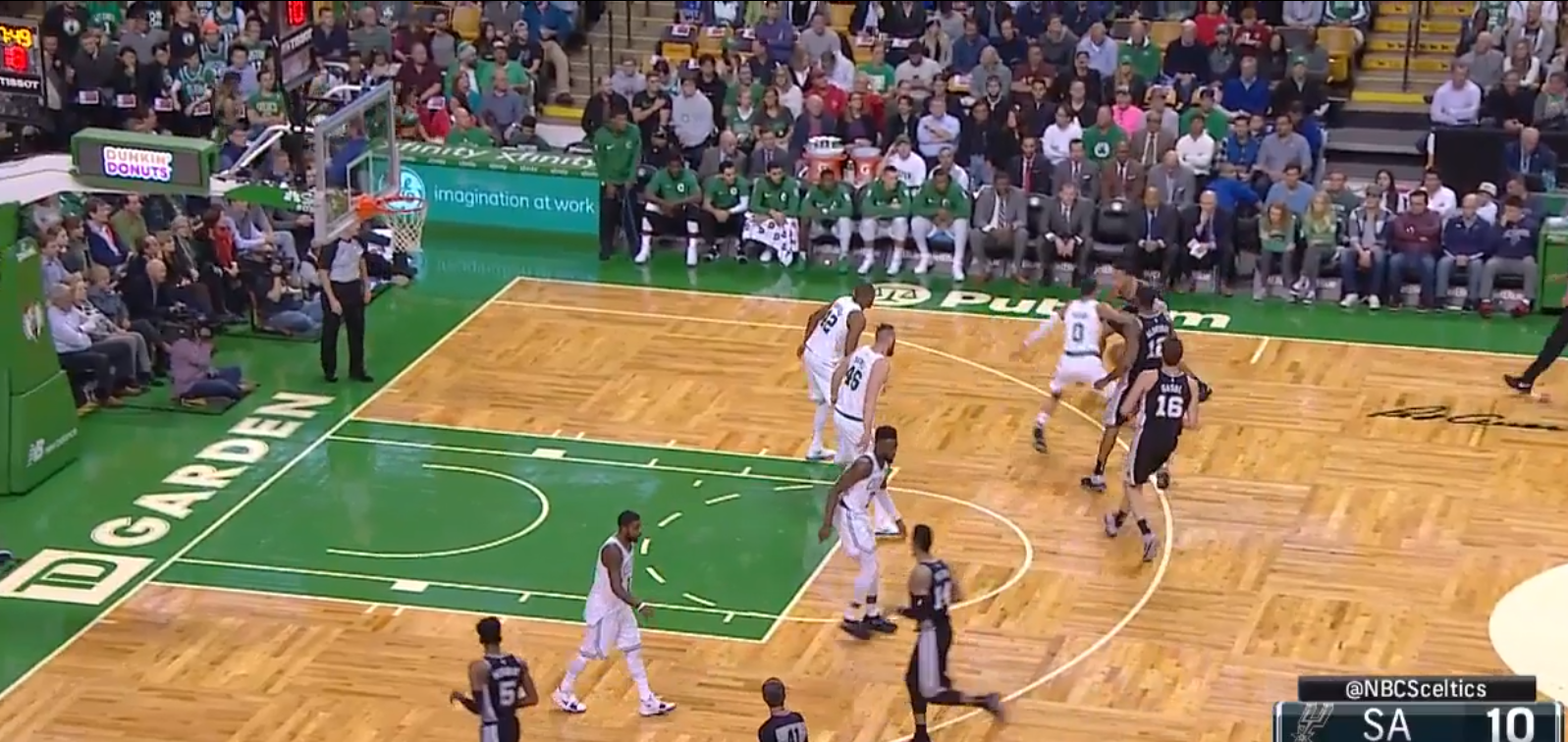
Notice how Al Horford has dropped back way off Aldridge to contain Anderson and prevent the drive. Baynes has dropped just enough to prevent Aldridge from having an open roll to basket.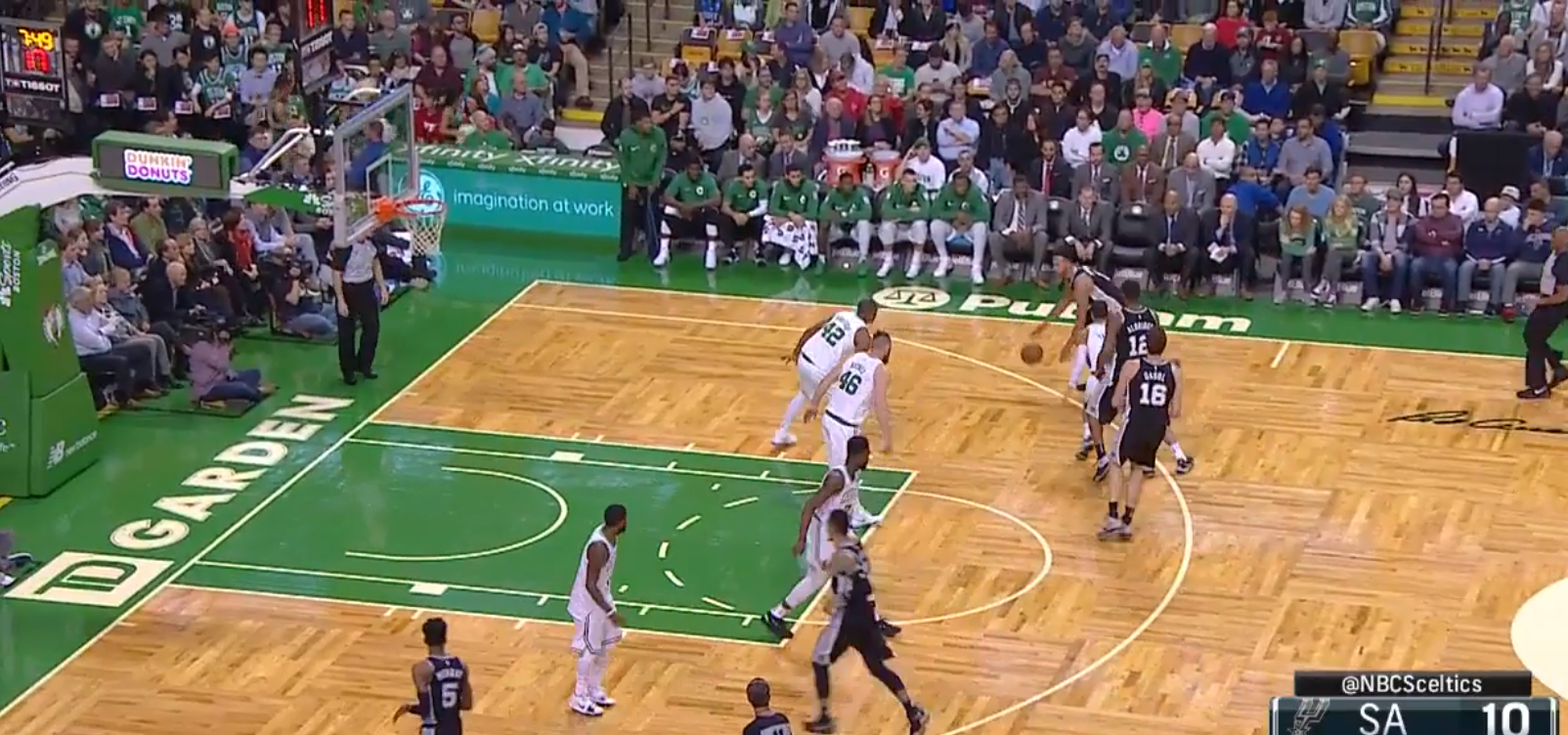
The ball handler is momentarily almost double teamed preventing him from driving.
If the pick and roll takes place in the centre of the court, the Celtics employ will attempt to force the ball handler onto his weak hand. You will sometimes hear players, often Horford or Baynes, or the coaching staff shout out “weak”. The concept is very similar to ice but involves stepping up high and overplaying the ball handler’s strong hand and forcing him onto his weak hand.
Powell comes to set a screen for Barea to allow him onto his stronger, right hand.
Smart steps his left foot out high so Barea cannot use the screen, forcing him onto his weaker left hand and towards the sideline.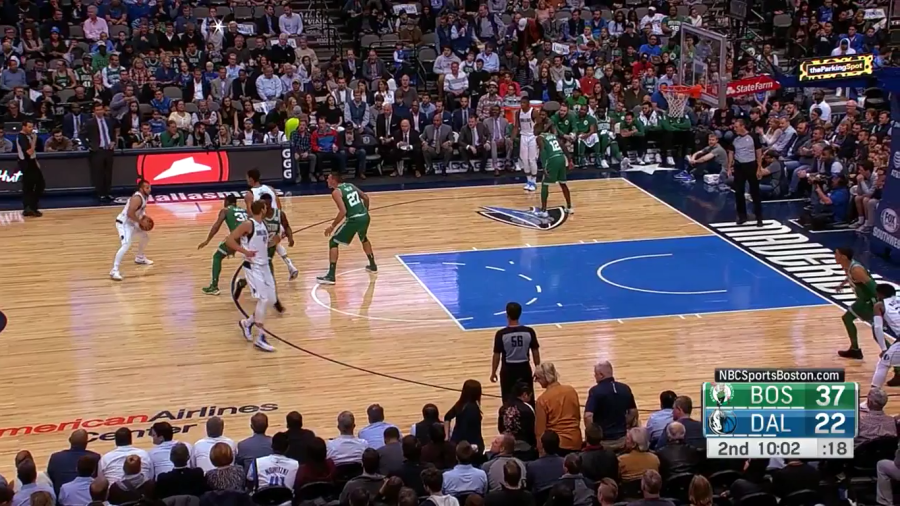
A common counter to this defense is for the screener to switch side as Powell does here. Smart is screened but Boston have achieved their aim of not allowing the ball to go to the middle of the floor.
Theis has dropped back to prevent Barea’s drive while Smart recovers, and Ojeleye drops back from Dirk just enough to prevent an easy pass to the rolling Powell.
These techniques have been so successful because in forcing the ball away from the middle of the court, passes are limited and made more difficult to execute. This is also one of the ways the Celtics have managed to defend the 3 point line, another defensive area they have excelled in, leading the league allowing just 31.6%. Lots of open 3 point shots come from middle penetration. The ball goes to the paint, defense is forced to scramble and collapse, then the ball is kicked out to open shooters. By keeping the ball away from the middle of the court and towards the sideline, Boston has limited the number of open 3pt looks they give up, and their long, athletic players closing out have made the shots that are taken, tough contested ones.
Switching and Versatility
Stevens has often used the phrase “positionless basketball” and that is another reason the Celtics have had such success defensively. It is a concept that has been widely embraced around the league in recent years, just look at the Bucks and their huge line up. It means switching against screens can help negate, or at least reduce the offensive team’s advantage.
Having the versatility of Jaylen Brown, Marcus Morris, Jayson Tatum and, of course, Al Horford, is a huge advantage for Boston. The huge wingspans of these players makes passing all the more difficult and also means they have the ability to switch at almost every position. Marcus Smart can have a terrible shooting night, but still has Brad Stevens’ trust enough for him to be on the floor in big moments. He makes huge defensive hustle plays, but also has the ability that very few guards have, to defend big guys on switches. He has the strength not to be pushed around , and the athleticism to be able to get up and challenge their shots.
One small but interesting, and effective technique they sometimes utilize is a slight delay in the switch with ball screens. This means that even though the players may have switched, the ball handler’s defender still will fight over the screen and chase the ball for a second applying a short double team to contain the ball before returning out to take his teammate’s man. An example from the same Spurs game.
Aldridge sets the screen, this time for Danny Green.
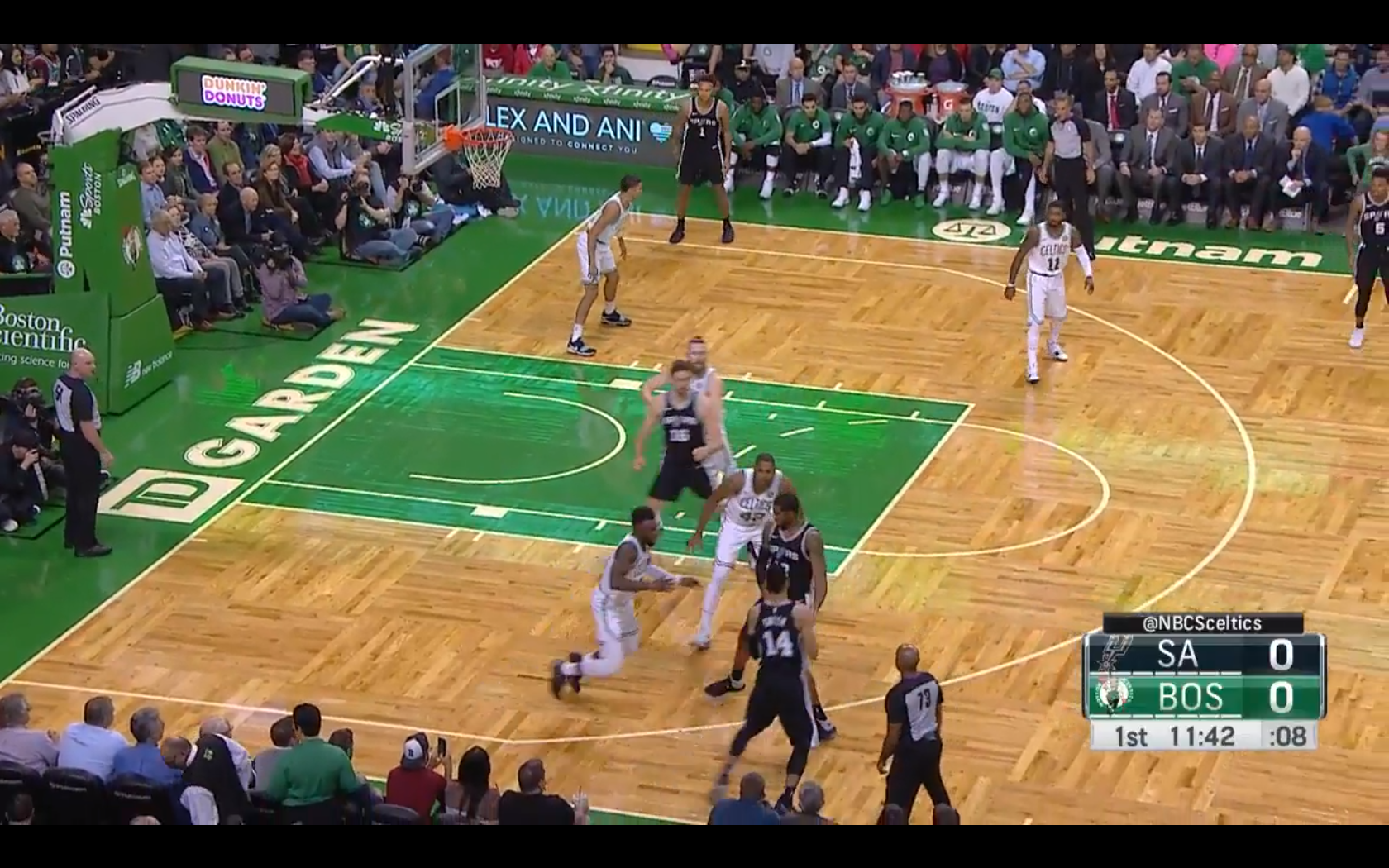
Jaylen Brown fights over it.

Despite knowing that he and Horford are switching, he pursues Green.

This creates a brief trap making it very difficult for Green to get near the basket.

Brown then turns to run out to Horford’s man, Aldridge.

He recovers and stays on the ground, forcing a tough contested 3.
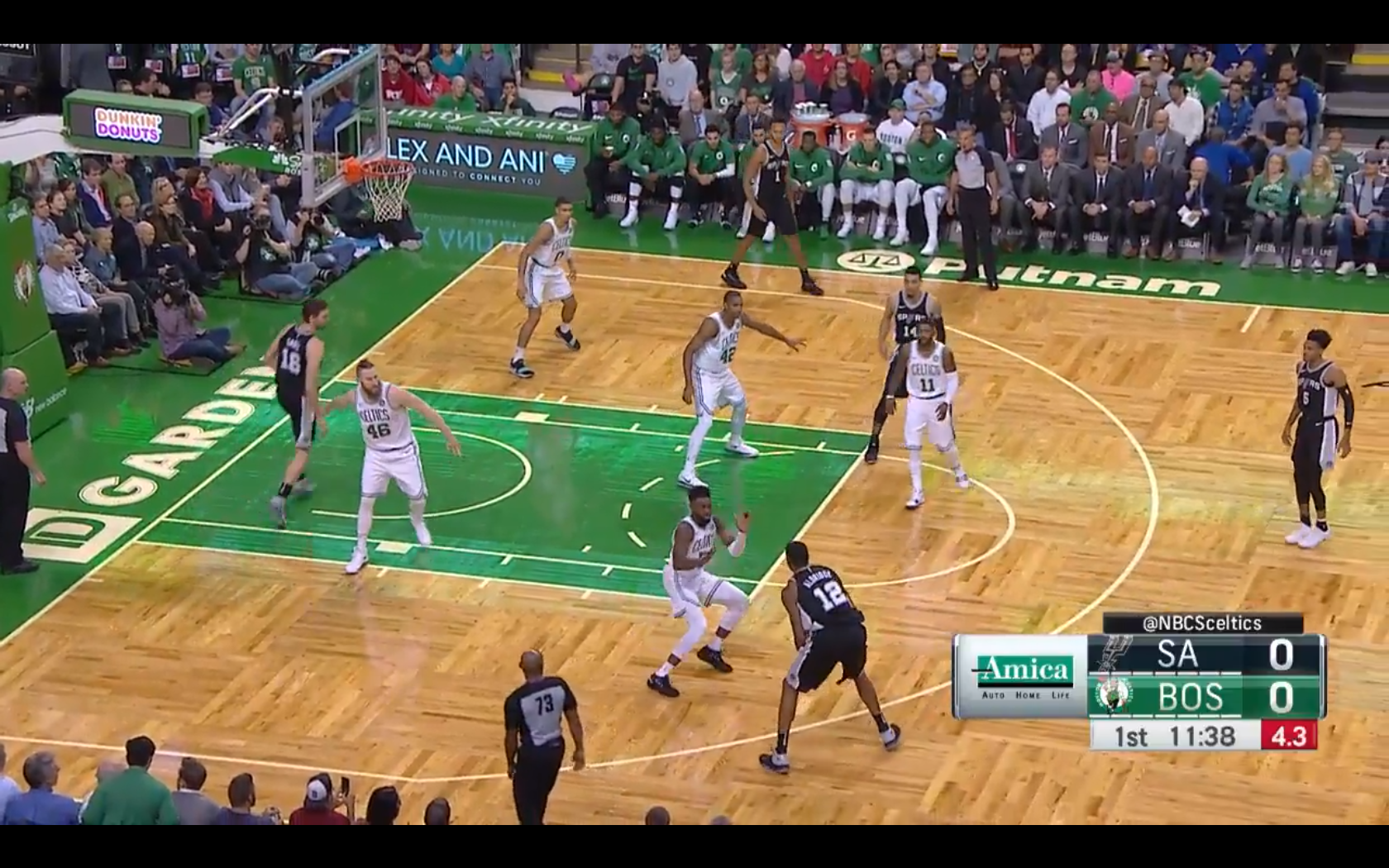
This requires high basketball IQ and perfect communication. If Brown and Horford are not quite on the same page, even for half a second, Green would have an easy layup, or Aldridge a wide open 3. These types of coverage aren’t unique, you’ll see most teams run similar things, but Boston’s skilled and intelligent roster is what has made them elite.
Kyrie is defending.
Isaiah Thomas was known as being one of the worst defenders in the league last year and, as mentioned, Irving wasn’t a whole lot better. The difference? While it was often clear that Thomas was trying hard defensively, at 5’8” he’s severely limited. Irving at 6’3” on the other hand has a clear size advantage but-, often just seemed to lack defensive effort. He would often get stuck on screens and get beaten off the dribble, struggling to keep the ball in front of him. The ability was clearly always there as he would sometimes show in big moments. Although Irving hasn’t exactly turned into Gary Payton this year, it’s clear that he’s made a huge step up in effort and aggression. Perhaps Stevens has found a way to connect with him and get the best out of him. Or perhaps he spent all summer hearing about how “he couldn’t win without Lebron James”, and how he was a “terrible defender”. Last year Irving was 51st overall in steals and so far this year is 14th and is noticeably more engaged on the defensive end.
Rebounding
Last year Boston ranked 27th in the league in rebounding and 25th in opponent’s rebounds but in the first 19 games are 5th and 8th respectively.

There are a few different reasons for this rebounding improvement. Simply, the lineups are bigger. 5’8″ Thomas has been replaced with 6’3″ Irving, 6’3″ Bradley replaced by 6’7″ Brown and 6’6″ Crowder replaced by 6’8″ Tatum. The size and physical presence of Aron Baynes is an obvious upgrade. While Amir Johnson was a decent positional defender, rebounding was not his strong suit. As mentioned, Horford seems more aggressive and his improved rebounding numbers show it. The length and athleticism of Jaylen Brown and rookie Jayson Tatum have also been major factors on the boards.
It’s a small sample size, after all we’re only talking about 19 games here but the fact that Boston has the best record and best defence in the league without Hayward, and other absences, is testament to the personnel and to Brad Stevens. The Celtics rank 2nd in 3pt defence but with the high variance that comes with 3pt shooting, it’s unlikely that the numbers will remain this high throughout the season so they will need to start becoming more productive offensively.
